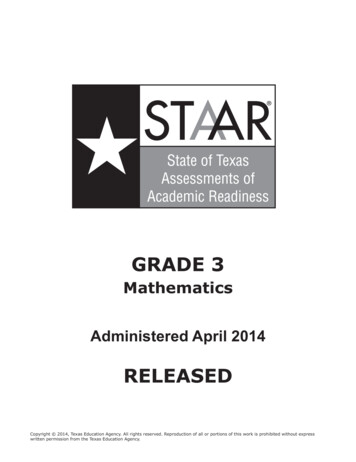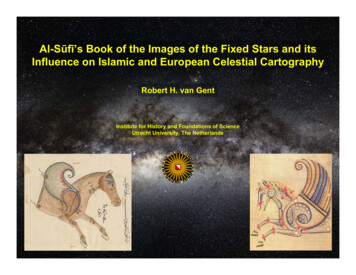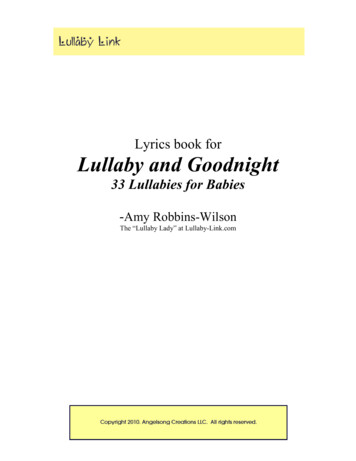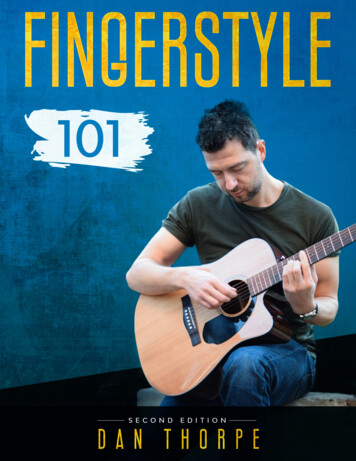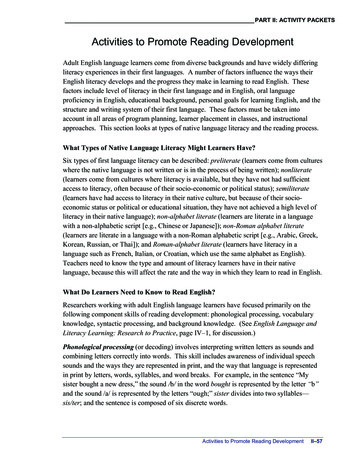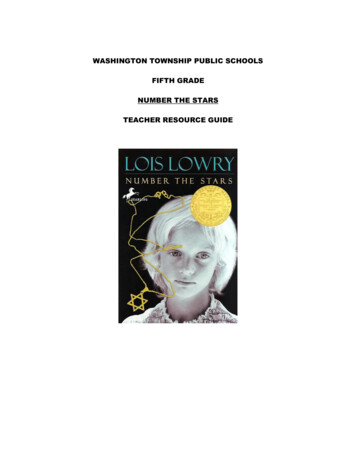
Transcription
WASHINGTON TOWNSHIP PUBLIC SCHOOLSFIFTH GRADENUMBER THE STARSTEACHER RESOURCE GUIDE
NUMBER THE STARS UNIT READING CALENDARWeek/Section1Lesson 1:WrittenConversations;Introducingthe genre andsettingWeek/Continued workSection on Section 12Begin Section 2Week/ (chapters 5-8)Section3Week/Section4Lesson:Close ReadingSection 2: Usenotes tocomplete theopen-endedquestionBegin work onWeek/ Section 4Section (chapters 14-17,Afterword)5Week/Section6Lesson:Close ReadingSection 4: Usenotes tocomplete theopen-endedquestionLesson 1:Introducingthe setting(continued):HolocaustContinued workon Section 1Continued workon Section 2Begin Section 3(chapters 9-13)Continued workon Section 4OptionalExtensionActivitiesRead aloudStar of Fear,Star of Hope;model thinkingaloud duringreading usingpost-it tenresponse forStar of Fear,Star of HopeCompletework onSection 1;optional OERusing adiscussionquestionLesson:Close ReadingSection 1:Complete notesfor discussionLesson:Close ReadingSection 1: Usenotes tocomplete theopen-endedquestionContinuedwork onSection 2Complete workon Section 2;optional OERusing adiscussionquestionLesson:Close ReadingSection 2:Read andcomplete notesfor discussionContinued workon Section 3Complete workon Section 3;Choose onediscussionquestion for awrittenresponseComplete workon Section 4;optional OERusing adiscussionquestionLesson:Close ReadingSection 4:Read andcomplete notesfor discussionContinuedwork onSection 3Continuedwork onSection 4OptionalExtensionActivitiesAssessmentBegin work onNumber theStars Section 1(chapters 1-4)Assessment
Overview of the TextNumber the Stars is told from the point of view of ten-year-old AnnemarieJohansen. The story is set in the city of Copenhagen, Denmark in September1943, the third year of the Nazi occupation of Denmark. Annemarie and her bestfriend Ellen, who is Jewish, are stopped by soldiers on their way home fromschool. The two girls, who go to the same school and live in the same building,are unsettled by their first direct encounter with the Germans. Mrs. Johansen andMrs. Rosen are concerned and ask the girls to take a new route to school. Theencounter makes Annemarie reflect on what her father has taught her aboutDenmark and also about her older sister Lise's death a few years before the startof the novel. Later in the fall, Annemarie and her younger sister Kirsti discoverthat Mrs. Hirsch's neighborhood shop has been closed. This event further alarmsMrs. Johansen, though Annemarie does not understand why.During a late night visit from Peter Neilsen, a member of the Resistance and theman Lise was to marry, Annemarie is told more about the war. Her parents andPeter explain that Jewish stores are being closed. The next day, the Rosensmust flee. They leave Ellen with the Johansens. During the night, Germansoldiers come to the apartment demanding that Mr. Johansen disclose thelocation of his friends. He refuses and they search the apartment. Ellen pretendsto be one of the Johansen's daughters, but her dark hair causes the solider to besuspicious. Luckily, Mr. Johansen is able to show them a baby picture of Lisewith dark hair, which convinces the soldiers.The next day, Mrs. Johansen takes the three girls to her brother Henrik's home inGilleleje, Denmark, where Henrik is a fisherman. They spend a peaceful day inthe house by the ocean before Henrik announces that their Great-aunt Birte hasdied. The service is to be held that evening. Annemarie knows that no such auntexists, and demands the truth. Uncle Henrik explains the importance of notknowing too much when bravery is needed. That night the coffin arrives and theygather around it. Many more people arrive, but all are silent. Soon Peter appearswith the Rosens, who are reunited with Ellen. Soldiers, drawn by the post-curfewlights, come to the house. They demand that the coffin be opened, a problemsince the coffin is empty. Mrs. Johansen thinks quickly and says that her auntdied of highly contagious typhus. The soldiers leave.Henrik takes the first group of people down to his boat. Mrs. Johansen followswith the Rosens. Annemarie, who now understands that the people are beingtaken to safety in Sweden, awaits her mother's safe return. When her motherdoes not appear, she discovers that Mrs. Johansen has broken her ankle.Because of this, Annemarie must take an important package to her uncle before
they can leave. On the way to the boat, soldiers with dogs stop her. They searchher basket and discover the package. But when they rip it open it contains only ahandkerchief, and they let her go. Annemarie makes it to the boat in time, toHenrik's evident relief.That evening, Henrik is safe at home having dinner with Annemarie, Kirsti, andMrs. Johansen, whose ankle has been taken care of by the local doctor. Afterdinner, Uncle Henrik takes Annemarie to learn how to milk the cow. They talkabout the events of the day. He explains that he hid his passengers in the bottomof the boat, and the handkerchief was essential because it kept the Germans'dogs from smelling the human cargo. Uncle Henrik praises Annemarie for herbravery and reassures her that Ellen is safe and they will meet again someday.The war ends in May, and Annemarie and her family watch from their balcony aspeople parade in the streets with the Danish flag. Annemarie thinks of theRosens and realizes that they, along with all the others who were forced to flee,will soon be returning home. Peter Nielsen has died. He was shot in a publicsquare for his involvement in the Resistance. Annemarie's parents tell her thatLise was a member of the Resistance, too, and that she did not die in anaccident, but was killed by the Germans. Thinking of Lise and of Ellen,Annemarie goes to the trunk of Lise's things in her room and takes out the Star ofDavid pendant that she has been keeping for Ellen. She says she will wear thenecklace herself until Ellen returns.(Provided by Sparknotes)
Whole Class Lesson #1, Day 1Setting the StageLearning about historical fiction and the HolocaustOverview:This lesson teaches students about the basic elements of both historical fictionand the Holocaust.Classroom Resources:Overhead projector/document olocaust.htmlInstructional Plan:The purpose of this lesson is to prepare students to read Number the Stars.Students need to understand the term historical fiction and its components. Moreimportantly, students need to gain an understanding of the who, what, when,where and why of the Holocaust.Instructions and Activities:1. Begin the lesson with a “written conversation”: Students write their names on the top of a piece of paper, thenrespond in writing to the prompt: Would you risk your life to saveanother person? Give students 2-3 minutes to write a briefresponse. Students should provide a few sentences for theirresponse. Students pass their paper to a classmate. Students read theresponse, then respond to what their classmate has written.Give students 2-3 minutes to write their responses. Students pass their papers to a third classmate. This time, theyread both written responses on the paper, add their own responseto what their classmates have written. Papers go back to the original writers. Students reread theiroriginal response, read the two responses provided by theirclassmates, and then write a brief final reflection.2. Discuss the term historical fiction with students. Guide the discussiontowards the idea that historical fiction, while a fictional story, is written toportray a time period or convey information about an important time periodor a historical event. Explain that at this point in history, many people werefaced with the decision whether or not to risk their own lives to help others.Orally discuss written students’ responses to this question.
3. Having browsed the websites above (or any additional ones you see fit),use the sites to introduce students to the Holocaust. Students should gainunderstanding of who was involved, when it took place, what occurred,where it occurred and why these events took place. Be very careful toscreen all sites carefully before presenting them under a documentcamera. Students should contribute their own schema of the Holocaustthroughout the discussion. (Optional: this task can be completed asstudent research with careful consideration of the sites accessed by thestudents.)Student Assessment/Reflections:Collect students’ written conversations to informally assess student responses.Informally assess students’ comprehension through questioning in groupdiscussion. Provide opportunities to turn and talk with partners while youcirculate the room to listen.
Whole Class Lesson #1, Day 2Setting the StageLearning about historical fiction and the HolocaustOverview:This lesson teaches students about the basic elements of both historical fictionand the Holocaust.Classroom Resources:Overhead projector/document olocaust.htmlMap of EuropeInstructional Plan:The purpose of this lesson is to prepare students to read Number the Stars.Students need to understand the term historical fiction and its components. Moreimportantly, students need to gain an understanding of the who, what, when,where and why of the Holocaust.Instructions and Activities:1. Review information discussed yesterday about historical fiction and theHolocaust.2. Continue to use previewed sites to introduce students to the Holocaust.Students should gain understanding of who was involved, when it tookplace, what occurred, where it occurred and why these events took place.Be very careful to screen all sites carefully before presenting them under adocument camera. Students should contribute their own schema of theHolocaust throughout the discussion. (Optional: this task can becompleted as student research with careful consideration of the sitesaccessed by the students.)3. Distribute map of Europe. Students will color this map according to thecode on the bottom of the page in order to gain an understanding of thelocations of the countries in Europe, which were under German control,which were Allied countries and which countries remained neutral.Student Assessment/Reflections:Informally assess students’ comprehension through questioning in groupdiscussion as well as map completion. Provide opportunities to turn and talk withpartners while you circulate the room to listen.
Lesson: Answering Open-Ended Questions(RL5.1)Overview: Students will use the acronym RACE to answer open endedquestions. It is expected that students use this model to answer open endedquestions for the remainder of the year.Resources: You will find a PowerPoint presentation and a handout about RACEon the e-board as well as a scoring rubric. This will be moved to the new website.1. Click “Teacher Resources.”2. Click Elementary English Language Arts3. Password: ELA4. Under ELA Overview, click white tab labeled, “Open-ended Questions (NJASK format) Grades 3-5The following acronym may be helpful in constructing aresponse R.A.C.E.Review the questionAnswer all parts of the questionCite specific details and support from the textExtend your response to push your thinkingR Review: Review the question. Make certain you understand all parts ofthe question. You may simply restate the question when answering theprompt. This creates a familiarity with the text and also shows the testgraders that you are aware of what is being asked.A Answer: Answer all parts of the question. If there are two bullets to aquestion, you are to answer each bullet. If the bullet itself has multipleparts, all parts must be answered to receive an acceptable score.C Cite: Cite evidence from the text to support your response. This isperhaps the most crucial element. Include direct support, in your response.This can be accomplished either in the form of quotes, paraphrases, orsummaries in your answer.The following transitions may be helpful : An example of this is I know this is true because The author says In the book/article on page it says In paragraph the author states E Extend: Extend your response to push your thinking. This can reallyincrease your scoring potential. Reflect on the question and answer andoffer some insight, whether it be a personal anecdote or global reference. Itcreates closure and offers the grader a chance to see you think"outside the box."
Activity: Read aloud Star of Fear, Star of Hope. Model thinking aloud usingpost-it notes to record questions and thoughts. Choose one of the followingquestions and model R.A.C.E to complete a written response.In the story, Helen says, “Some pretty strange things werehappening that night.” Identify one (1) thing that was strange to Helen from thestory. Explain the real reason why you think the strange thingshappened using details from the story.What did Lydia’s mother mean when she said, “The place forstars is in the sky. When people take them down from the skyand sew them on their clothes, it only brings trouble.” Describe a type of trouble that came to the Jewish peoplewho had to wear the stars.
NameWordPageNumber the StarsBefore readingDuring readingAfter ReadingBKI already know thisword.CCI understand the meaningof this word from thepassage.Dictionary DefinitionI need to look up thisword.
Number the Stars: Section 1Chapters 1-4Overview: In this section, the teacher reads aloud to the students and modelsreading fluency as well as modeling/sharing thoughts. The teacher may decideto use post-it notes, reader’s notebook, or discussion to share thoughts with theirstudents. Students may discuss the suggested discussion questions orally wholegroup or small group. At the end of the section, students will reread a section ofthe text as a close read, and answer an open-ended question.Suggested Vocabulary: (RL5.4) Use the following terms to determine meaningused in context. Teach students how to use context clues to determine meaningof words. Students can use the vocabulary chart to identify words they know fromusing background knowledge (BK), context clues (CC), or the dictionary.Students may create their own sentences using words.contempt (p.3)obstinate (p.4)occupation (p.6)sabotage (p.8)impassive (p.10)trousseau (p.14)fiancé (p.17)rationed (p. 18)scampered (p. 18)haughtily (p. 19)tormenting (p. 24)synagogue (p. 35)Sentence using good context clues:Food has to be during wartime when much of theproduce was shipped to feed the troops.Sentence without context clues:Food has to be .Sentence using good context clues:The five year old refused to clean her room even after hermother threatened to punish her.Sentence without context clues:The five year old was acting .Suggested Discussion Questions: (RL5.1) Use the following questions to holda discussion with class. Students should also respond to questions by quotingaccurately from the text when explaining what the text says explicitly or whendrawing inferences.1. Describe Annemarie and Ellen. Include character traits and physicaldescriptions. Why do you think the physical descriptions of Annemarie andEllen are so important to this story?2. In what ways did the Johansen’s and Rosen’s demonstrate their strongbond of friendship during the war?3. How did the people of Demark feel about King Christian? Which words orincidents gave you information about the way the Danes felt?4. What were some of the everyday hardships that the Johansens and theRosens had to face because of the war?
Open-Ended Response: Section 1Use your discussion notes and evidence from the story to answer thefollowing question. In your response, be sure to use evidence you havegathered from the text. You may want to use the graphic organizer toorganize your thinking.On pages 2-6, Annemarie and Kristi see the soldiers in twovery different ways. How does the author show that theirpoint of view is different? Why is their point of viewdifferent?
EvidenceThings AnnemarieSays or Does:Things Kirsti SaysOr Does:What this tells us about their point of view?
General Directions for Close Reading(Sections 1,2, and 4)Close reading requires students to reread and revisit important partsof the text. Close reading does not occur during the initial reading ofthe text. After reading a section of the book, students will return to aspecific part to reread, discuss, and deepen their understanding ofimportant themes, vocabulary, and events in the book.Day One: The teacher will pass out the close read with guiding questions.Students should read the section on their own and take notes onthe questions. Students can write their initial thoughts about thissection in the space provided. It is important that students have theopportunity to wrestle with complex text and challenging questionson their own before group discussion.Next, the teacher reads section aloud to students. Students andteacher discuss the guiding questions.Students add to and amend their notes as needed. This is animportant part of the process as it requires students to use thediscussion to revise their initial thinking.Day Two: In order to prepare for the open-ended question, students can beguided to review their notes from the group discussion andcomplete the graphic organizer. They may also continue thediscussion and revision of their notes.Students use their notes and graphic organizer to complete theopen-ended question. Students should be encouraged to completetheir responses in 20-25 minutes. The teacher can provide supportas needed for this activity.
Close Read: Number the Stars: Section 1Guiding QuestionsSection 1 Close Read (Part 1 – page 2)How does Annemarie describe the soldiers? Whatdoes Annemarie notice about the soldiers?“Halte!” the soldier ordered in a stern voice.The German word was as familiar as it wasfrightening. Annemarie had heard it often enoughbefore, but it had never been directed at her untilnow.Behind her, Ellen also slowed and stopped. Farback, Kirsti was plodding along, her face in a poutbecause the girls hadn’t waited for her.Annemarie stared up. There were two ofthem. That meant two helmets, two sets of cold eyesglaring at her, and four tall shiny boots planted firmlyon the sidewalk, blocking her path to home.And it meant two rifles, gripped in the hands ofthe soldiers. She stared at the rifles first. Then,finally, she looked into the face of the soldier whohad ordered her to halt. They yell at her in stern voices She sees helmets, cold eyes, shiny boots, andrifles. She does not describe them as wholepeople, but as parts. She does not even notice their faces until last. She sees the rifles first. They block her from home.What does this reveal about how she feels/how shesees these soldiers? She does not see them as human or friendly.She fears them.They are forces of violence.They are cold, hard.They can change a moment from light-heartedand fun into something dark and fearful. They could take away her feelings of well-beingand safety. They can have an impact on herself, herfriends, and her family.
Section 1 Close Read (Part 2 – page 4)Guiding Questions“And who is this?” he asked, looking toAnnemarie’s side. Kirsti had appeared theresuddenly, scowling at everyone.How does Kirsti react to the soldiers?“My little sister.” She reached down for Kirsti’shand, but Kirsti, always stubborn, refused it andput her hands on her hips defiantly.The soldier reached down and stroked her littlesister’s short, tangled curls. Stand still, Kirsti,Annemarie ordered silently, praying thatsomehow the obstinate five-year-old wouldreceive the message,But Kirsti reached up and pushed the soldier’shand away. “Don’t,” she said loudly. May need to discuss vocabulary such as scowl,defiantly, and obstinate. She puts her hands on her hips. She yells at them when they stroked her hair. She pushed the soldier’s hand away.What do Kirsti’s reactions show about her and eventsgoing on around her? She has no fear of the soldiers. She does not see them as a threat to herself oranyone close to her. They are not strangers who need to be treatedwith respect and/or fear. She sees them as people who can be defied. They represent something common.
Section 1 Close Read (Part 3 – page 5)Guiding QuestionsWhen they were almost home, Ellen whisperedsuddenly, “I was so scared.”What does the phrase “catch the eyes” mean?“Me too,” Annemarie whispered back.As they turned to enter their building, bothgirls looked straight ahead, toward the door. Theydid it purposely so they would not catch the eyes orthe attention of two more soldiers, who stood withtheir guns on this corner as well. Kirsti scurriedahead of them through the door, chattering aboutthe picture she was bringing home from kindergartento show Mama. For Kirsti, the soldiers were simplypart of the landscape, something that had alwaysbeen there, on every corner, as unimportant aslampposts, throughout her remembered life. To draw attention to oneself To make oneself noticeableWhy is the author using this phrase here? What doesit reveal? The girls show their continued fear of whatcould happen to them or their families. The girls recognize that the best way to be safeis to stay out of the soldiers’ radar. Theyunderstand the need to be invisible so theinvaders have no reason to attack or harmthem or their family. The girls want to be left alone. They do notwant to become a part of anything that couldraise an alarm or get them in trouble. They do not know what the reaction of thesoldiers could be if provoked, so it is best toavoid them if at all possible.
Close Read: Number the Stars: Section 1Guiding QuestionsSection 1 Close Read (Part 1 – page 2)How does Annemarie describe the soldiers? Whatdoes Annemarie notice about the soldiers?“Halte!” the soldier ordered in a stern voice.The German word was as familiar as it wasfrightening. Annemarie had heard it often enoughbefore, but it had never been directed at her untilnow.Behind her, Ellen also slowed and stopped. Farback, Kirsti was plodding along, her face in a poutbecause the girls hadn’t waited for her.Annemarie stared up. There were two ofthem. That meant two helmets, two sets of cold eyesglaring at her, and four tall shiny boots planted firmlyon the sidewalk, blocking her path to home.And it meant two rifles, gripped in the hands ofthe soldiers. She stared at the rifles first. Then,finally, she looked into the face of the soldier whohad ordered her to halt.What does this reveal about how she feels/how shesees these soldiers?
Section 1 Close Read (Part 2 – page 4)Guiding Questions“And who is this?” he asked, looking toAnnemarie’s side. Kirsti had appeared theresuddenly, scowling at everyone.How does Kirsti react to the soldiers?“My little sister.” She reached down for Kirsti’shand, but Kirsti, always stubborn, refused it andput her hands on her hips defiantly.The soldier reached down and stroked her littlesister’s short, tangled curls. Stand still, Kirsti,Annemarie ordered silently, praying thatsomehow the obstinate five-year-old wouldreceive the message,But Kirsti reached up and pushed the soldier’shand away. “Don’t,” she said loudly.What do Kirsti’s reactions show about her and eventsgoing on around her?
Section 1 Close Read (Part 3 – page 5)Guiding QuestionsWhen they were almost home, Ellen whisperedsuddenly, “I was so scared.”What does the phrase “catch the eyes” mean?“Me too,” Annemarie whispered back.As they turned to enter their building, bothgirls looked straight ahead, toward the door. Theydid it purposely so they would not catch the eyes orthe attention of two more soldiers, who stood withtheir guns on this corner as well. Kirsti scurriedahead of them through the door, chattering aboutthe picture she was bringing home from kindergartento show Mama. For Kirsti, the soldiers were simplypart of the landscape, something that had alwaysbeen there, on every corner, as unimportant aslampposts, throughout her remembered life.Why is the author using this phrase here? What doesit reveal?
Number the Stars: Section 2Chapters 5-8Overview: In this section the teacher will decide small group assignments forthe class. Please note that students should not be participating in round robinreading. They may partner read or read a few pages silently and discuss as agroup and continue. Teacher may give group task or discussion questions tofocus on. Students should continue to practice recording and sharing theirthoughts. As the groups meet to read, teacher will circulate. During this section,students should continue to use context clues. At the end of the section,students will reread a section of the text as a close read, and answer an openended question.Suggested Vocabulary: (RL5.4) Use the following terms to determine meaningused in context. Teach students how to use context clues to determine meaningof words. Students can use the vocabulary chart to identify words they know fromusing background knowledge (BK), context clues (CC), or the dictionary.Students may create their own sentences using words.imperious (p. 39)Star of David (p. 41)imprinted (p. 49)tentatively (p. 50)specter (p.69)harbor (p. 62)casket (p. 72)Suggested Discussion Questions: (RL5.1) Use the following questions to havegroups discuss and then share with the class. Students should be able torespond to questions by quoting accurately from the text when explaining whatthe text says explicitly or when drawing inferences.1. There are several differences between life Copenhagen and onHenrik’s farm. Compare and contrast life, as Ellen and Annemarieexperience it, in the two places.2. Annemarie feels safe in her home. How does the author use specificdetails on pages 42-43 to create this mood?3. How is the officer (p. 46) different than the Nazi (the Giraffe) in thebeginning of the novel (p. 3)?4. As a group discuss Uncle Henrick. Where does he live and what doeshe do for a living? Make a prediction about his role in the comingchapters.5. Why do you think Mr. Johansen felt he had to use a code whenspeaking to Uncle Henrik?6. Reread pages 68-69. What words and phrases does the author use toindicate a change in mood?
Open-Ended Response: Section 2Use your discussion notes and evidence from the story to answer thefollowing question. In your response, be sure to use evidence you havegathered from the text. You may want to use the graphic organizer toorganize your thinking.On pages 60-66, the author describes the setting and eventsat Uncle Henrik’s farm. How does the author create a peaceful mood? How do the characters’ words and actions let you knowthat even this setting is dangerous?
Words and PhrasesCreatesPeaceful MoodCreates Moodof Danger
Close Read: Number the Stars: Section 2Guiding QuestionsSection 2 Close Read (Part 1 – page 60)How is the setting described?The House by the Sea“Oh, Annemarie,” Ellen said, with awe in her voice, “itis beautiful.”Annemarie looked around and nodded her head inagreement. The house and the meadows that surrounded itwere so much a part of her childhood, a part of her life, thatshe didn’t often look at them with fresh eyes. But now shedid, seeing Ellen’s pleasure. And it was true. They werebeautiful.The little red-roofed farmhouse was very old, itschimney crooked and even the small, shuttered windowstilted at angles. A bird’s nest, wispy with straw, was halfhidden in the corner where the roof met the wall above abedroom window. Nearby, a gnarled tree was still speckledwith a few apples now long past ripe.Mama and Kirsti had gone inside, but Annemarie andEllen ran across the high-grassed meadow, through the lastwildflowers. From nowhere, a gray kitten appeared and ranbeside them, pouncing here and there upon imagined mice,pausing to lick its paws, and then darting off again. It’s beautiful They remind Annemarie of her childhood The house is old and has imperfections, but hasa country, cottage feel There is a kitten running around in the grassmeadow sprinkled with wildflowers.What mood is created by this description? There is a nostalgic feeling. She reflects backon her childhood and the time she spent there. It is a free mood. They run in the meadow andchase the kitten. There is a quaint, feeling about that slightlycrooked house. It is not a frightening place, butjust old and settled in. There is a bucolic quality to the place.
Section 2 Close Read (Part 2 – page 63)Guiding Questions“I took Ellen down to show her the sea,” Annemarieexplained when they reached the place where Mama waited.“She’d never been that close before! We started to wade, but itwas too cold. I wish we had come in the summer so we couldswim.”What are some of the things that Mama says that letthe reader know that danger lurks beneath thepeaceful scene?“It’s cold even then,” Mama said. She looked around. “Youdidn’t see anyone, did you? You didn’t talk to anyone?”Annemarie shook her head. “Just the kitten.” Ellen hadpicked it up, and it lay purring in her arms as she stroked its smallhead and talked to it softly.“I meant to warn you. You must stay away from peoplewhile you are here.”“But there is no one around here,” Annemarie remindedher.“Even so. If you see anyone at all – even someone youknow, one of Henrik’s friends – it is better if you come in the house.It is too difficult – maybe even dangerous – to explain who Ellen is.”Ellen looked up and bit her lip. “There aren’t soldiers here,too?” she asked.Mama sighed. “I’m afraid there are soldi
Number the Stars is told from the point of view of ten-year-old Annemarie Johansen. The story is set in the city of Copenhagen, Denmark in September 1943, the third year of the Nazi occupation of Denmark. Annemarie and her best friend Ellen, who is Jewish, are stopped by soldiers on their way home from school.
